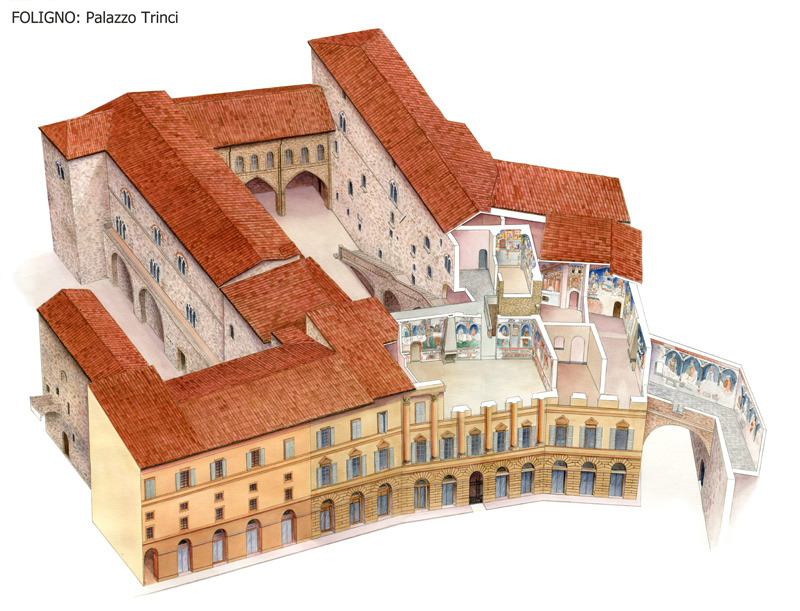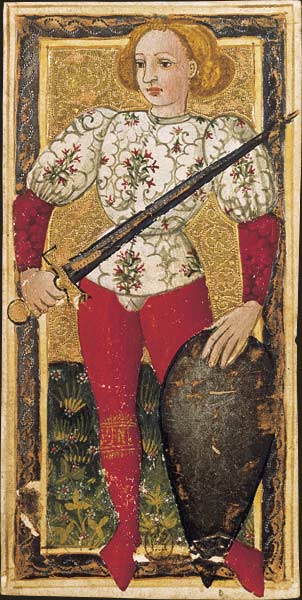mikeh wrote:Huck wrote,
Well, it's better to get the facts first.
Well, yes, I was disappointed that Maggio didn't have more. But perhaps there are no more "facts" about what is on the paper along with the dates.
They could present pictures of the writing. At least they could provide the text, which they can read. How can they know, that it are notarial acts? So they must be able to read something.
When we don't have the facts, we have to speculate, but not just wildly, but with probabilities, based on various conditions known and assumed. In dealing with the dating of cards, that is inevitable. We can get "no earlier than"'s sometimes, or, less frequently, "no later than"'s. In this case, no earlier than 1428. Beyond that, it is probabilities. I would guess that with Notorial Acts, that between 1428 and 1448 is more likely than between 1448 and 1468. Notorial Acts tend to be humdrum, and if not, then not recycled at all. That is my guess; but I would like to know more about the cards found in Ronciglione dated by "juridical papers". From what I see at
http://askalexander.org/display/23121/T ... onciglione, the proofsheets were in the binding of books of certain dates. That is a different kind of case, and it seemed to be reliable. Was there a problem?
The juridical texts have a date (something around 1580, if I remember correctly), but the date of bookbinding is not given. It's easily possible, that it was done decades later (or more). Similar it's with books, which were printed and send for sale without book-binding. If you find playing cards sheets in the book-binding of a book from the year xxxx, it doesn't mean automatically, that the playing cards have the same printing year. They could be from an earlier time (less probable) or from a later (more probable).
I picked Lo Scheggia rather than Apollonio because Apollonio is younger and so more likely to re-use something from an older peer. It is the same between Scheggia and Dal Ponte. The Apollonio illumination that is like the Stag Rider in "pectorals" (Maggio's term) in a c. 1450 Virgil; then probably the Lo Scheggia cassone lid is before then, the younger borrowing from the older. If Alessandro Sforza is being depicted as a young King of Diamonds, then late 1430s, after a famous victory, is more likely than late 1460s, at the end of his career winning stalemates. But nothing is certain. Even in the case of the Rosenwald sheet that Franco dated, it is an assumption that the sheets the proof-sheet is between means that they were done around the same time. Maybe the person who saved them had a different reason for putting the pages there. Maybe he or she simply used the book-pages as a means of protecting the proof-sheet from accidental damage, and they are there just because they were ready to hand, in some later century. That seems less likely to me, however, than the other assumption.
I don't get, that the moment of August 1435 was a very important event for Alessandro ...
https://it.wikipedia.org/wiki/Niccol%C3%B2_Fortebraccio
A questo punto fu formata una lega contro il Fortebraccio al comando di Francesco Sforza. Il 15 agosto 1435 Niccolò sconfisse e fece prigioniero Leone Sforza, ma il 23 agosto Alessandro Sforza lo sconfisse nell'assedio di Fiordimonte, presso Camerino. Mentre fuggiva con i suoi uomini, nel tentativo di saltare un fossato rimase ferito e bloccato sotto il peso del cavallo. Qui fu ferito a morte da Cristoforo di Forlì e spirò dopo due ore, senza proferir parola.
Francesco Sforza as leading general, Alessandro Sforza as his helper, Leone Sforza as a prisoner and Christoforo di Forli as the one, who actually killed Fortebraccio.
http://www.condottieridiventura.it/inde ... dro-sforza
... makes not much of this event
The battle of Montefalco (August 1435), when Leone Sfora was captured and also others, is described with ...
"Venturieri: 700 cavalli; sforzeschi: 600 cavalli. Fra gli sforzeschi sono catturati 300 cavalli e 200 fanti."
The battle of Fiordimonte (also August 1435), when Fortebraccio was fatally wounded, is described with ...
"Veneziani: 600 cavalli. I venetofiorentini si impadroniscono dei carriaggi."
Alessandro Sforza is given at 3rd place, so not as the leading general.
March 1436: "E' nominato governatore di Fermo in assenza del fratello Francesco." He became governor of Fermo, when his brother Francesco Sforza wasn't present. This naturally prepared, that he later got the nearby Pesaro (130 km in Northern direction) and became a dominant factor in the region.
Google-translator makes of the last 2 months of Fortebraccio this ...
July 1435:
With the collaboration of Corrado Trinci and Francesco Piccinino (700 horsepower) covering sixty miles quickly, attacking suddenly Leone Sforza and does a prisoner in Montefalco with all his troops (300 horsepower and 200 foot soldiers) while playing chess.
August 1435
Besieges the fortress of Montefalco; defenders surrender to terms; against every promise is beheaded Francuzzo from San Severino who had taken refuge: according to other sources Niccolo Fortebraccio grants the commander opponent a safe conduct, except to attack him and kill him at a later ambush. You wait, then, on the Chienti Beldiletto, it starts against Camerino controlled by Francesco Sforza. Storm the castle of Prefoglio (sacked) and the Apennines after a short bombardment; it leads to Serravalle di Chienti with 1,000 horsepower and 500 foot soldiers to rescue the prey; moves all 'siege of Fiordimonte in the valley of Sant'Angelo di Camerino. At the end of the month it will be addressed by Taliano Furlano, by Taddeo d'Este, by Cristoforo da Tolentino, by Guidantonio Manfredi, from Manno Barile, from Gattamelata, by Brandolini Brandolini and Alessandro Sforza. His troops take flight after a brief confrontation; Niccolo Fortebraccio falls from his horse in jumping a ditch and the enemies are upon him. Pretending to surrender and earns time to pull out the sword; the contrasts Cristoforo da Forli wounding him mortally. The latter stands still and does not allow anyone to lend him aid; the Fortescue dies after two hours without a word. It is said that his body was torn to pieces by Perugia leaked and that it was put in a sack. E 'it buried in Assisi. Remembered by Lorenzo Spirito in "Lamento di Perugia subjugated". Portrait of Bramantino.
http://www.condottieridiventura.it/inde ... rtebraccio ... (google-translated)
The truth seems to be, that an alliance was formed against Fortebraccio (who had caused a lot of trouble before) and that this ended Fortebraccio's career.
Well, I can't see, which personal big victory Alessandro had then.











